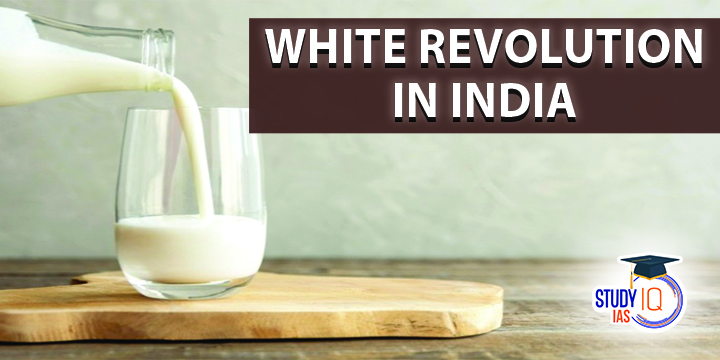Table of Contents
White Revolution in India
India’s national dairy development effort was called The White Revolution or Operation Flood. Verghese Kurien, an agricultural scientist, started it in 1970. This revolution’s main goals were to make milk more widely available at reasonable rates and to enhance the standard of living for small farmers who relied on agriculture for a living. Millions of previously unemployed unskilled labourers now have jobs thanks to this revolution, which also rebuilt rural infrastructure.
India’s “White Revolution,” often referred to as “Operation Flood,” is the uprising that is attributed to a significant increase in milk output there. India was supposed to become an independent milk-producing country during the White Revolution. Dr. Verghese Kurien is recognized as being the father of India’s White Revolution, and the country today produces the most milk in the world.
To accomplish these goals, two national organizations—the National Dairy Development Board and Amul—from the Gujarati city of Anand joined forces. Together, they founded a number of cooperatives around India that would purchase fresh milk from neighbourhood farmers at fair prices and give them access to new machinery and technology to boost production levels without requiring a lot of financial investment.
Read about: Countries and Capitals
White Revolution or Operation Flood History
Indira Gandhi, the nation’s prime minister at the time, oversaw the White Revolution in India. Its main goals are to increase peoples’ standards of living and make India self-sufficient in milk production.
In Motihari, Bihar, on October 2, 1970, Mrs. Gandhi launched the White Revolution. To provide low-income households with a reliable supply of milk at a fair price and to boost their nutritional status, 100 cows were imported from New Zealand.
The movement sought to raise consumption through better marketing infrastructure and greater pay levels for farmers, improve living circumstances for cattle, and raise nutritional standards for consumers across India. It also sought to increase productivity and profitability.
Read about: Land Reforms in India
Father of White Revolution in India
The White Revolution’s founding father is Dr. Verghese Kurien. He was born on March 28, 1921, to a farming family in Kozhencherry, Kerala. The National Dairy Development Board was founded by Dr. Kurien, who also served as its chairman (NDDB). From 1965 until 2008, he served as its chairman. From 2009 until his passing in 2012, he served as executive chairman.
Amul Cooperative Union Limited, founded by Dr. Kurien in 1965, has expanded into a Rs 50,000 crore brand with over 12 million milk producers throughout Gujarat. There is a high demand for dairy products made from Indian cows’ milk in markets throughout India and beyond, including the USA and Europe, thus these milk producers regularly supply milk under the Amul brand name through their local unions.
Read about: Gallantry Awards in India
White Revolution in India Objectives
Under the auspices of Operation Flood, a connection between milk farmers and consumers nationwide was established in 1970. This approach, which was implemented in more than 700 cities and towns, ensures that milk prices do not vary seasonally or regionally. The cooperative arrangement made guaranteed that milk farmers received all of their income from final customers.
These are the White Revolution’s Main Goals:
- Increasing the rural population’s income
- Increasing milk production nationwide to create a flood of milk
- Sell milk in the nation at reasonable costs.
Read about: Earthquakes in India
White Revolution in India Phases
Phase I: It began in 1970 and continued for ten years, or until 1980. The World Food Program received donations of butter oil and skim milk powder from the European Union, which were sold to pay for this phase.
At the beginning of Phase I, specific goals were established for the program’s implementation. One such objective was to enhance the milk marketing strategy in major cities to achieve the objectives.
Phase II: It lasted from 1981 to 1985 for five years. This phase saw a rise in milk sheds from 18 to 136, an increase in milk outlets to roughly 290 metropolitan markets, and the establishment of a self-sustaining system with 4,250,000 milk producers divided among 43,000 local cooperatives. Due to the cooperatives’ direct selling of milk, domestic milk powder output surged from 22,000 tonnes in 1980 to 140,000 tonnes by 1989, and the sale of milk likewise increased by several million litres per day. The Operation Flood-implemented dairies were the only cause of all output improvements.
Phase III: It lasted from 1985 until 1996, or approximately 10 years. This phase put the program’s finishing touches on while allowing the dairy cooperatives to grow. Additionally, it fortifies the infrastructure needed to obtain and market rising milk volumes.
73,930 dairy cooperatives with a combined membership of more than 3.5 crore dairy farmers had been established by the time White Revolution or Operation Flood came to an end. Several hundred highly effective Cooperation currently exist in India as a result of the White Revolution. The prosperity of many Indian communities is thus due to the revolution.
Read about: Exogenic and Endogenic Forces
White Revolution in India Impacts
The White Revolution has been to the development of dairy what the Green Revolution was to the cultivation of grains. Improved cow breeding practices and the application of new technology are the factors that influence the outcome. India currently produces the most milk in the world. The White Revolution had a significant impact on rural inhabitants, and many of them were motivated to undertake dairying as a side business.
India is now the world’s largest producer of milk. Over 112 million tones of milk were produced in 2009–2010, compared to approximately 17 million tons in 1950–1951. When compared to the scenario prior to independence, milk output has increased more than six times. Currently, there is around 263 gram of milk available per person every day, compared to 125 gram before the White Revolution.
Milk output and imports have significantly decreased. The White Revolution has been as crucial to the development of the dairy industry as the Green Revolution has been to gram production. The use of new technologies and improved cow breeding are the factors that determine its outcome. India currently produces the most milk in the world, ranking first.
The White Revolution has primarily benefited landless laborers and small and marginal farmers. 1, 35,439 dairy cooperative groups at the village level now cover over 14 million farmers. At Anand, Mehsana, and Palanpur, research centers have been established to guarantee the success of the Operation Flood Program (Banaskantha). Also operating are three regional centres in Siliguri, Jalandhar, and Erode.
A pilot program for the Livestock Insurance Scheme in 100 chosen districts across the nation was approved in February 2006 and implemented in 2006–07. The program attempts to shield farmers from financial losses brought on by the unexpected death of livestock. Extensive cross-breeding has been started to increase the quality of animals. Major health initiatives have been started to guarantee the maintenance of the disease-free status. In 2005–2006, the government experimented with livestock insurance.
Read about: Natural Vegetation in India
White Revolution or Operation Flood FAQs
Q) Who started first White Revolution in India?
Ans. India was supposed to become a milk-producing nation independently during the White Revolution. Today, India is the world’s top milk producer, and Dr. Verghese Kurien is credited with starting the White Revolution in that country.
Q) When was White Revolution started in India?
Ans. The world’s largest dairy development initiative, known as the “White Revolution,” was launched by India in 1970 under the direction of Dr. Verghese Kurien. Operation Flood, as it is often known, made the country with a shortage of dairy products the world’s top producer of milk.
Q) What happened in White Revolution in India?
Ans. The initiative known as “White Revolution” was started by Operation Flood. By removing the intermediaries, it established a national milk grid that connected farmers all across India to consumers in more than 700 towns and cities, decreasing seasonal and regional price differences while assuring that farmers receive the lion’s share of the profits.
Q) What is White Revolution explain?
Ans. Operation Flood, another name for the white revolution, was started in 1970. Minister Lal Bahadur Shastri was the one who started it. It turned India, which lacked access to milk, into the largest milk producer in the world. The white revolution was credited to Dr. Verghese Kurien.
Q) Who launched White Revolution?
Ans. Pharam Vibhushan Dr. Verghese Kurien, known as the “Father of the White Revolution in India,” passed away on September 9, 2012, and was 90 years old. Dr. Kurien, who was born in Kozhikode, Kerala, on November 26, 1921, graduated from Madras University with a Bachelor of Mechanical Engineering degree in 1943.
Major Incidents in Indian History
- Quit India Movement
- Chauri Chaura Incident
- Jallianwala Bagh Massacre
- Green Revolution in India
- Non-Cooperation Movement
Famous Personalities Biography
Mangal Pandey |
Maharana Pratap |
Rabindranath Tagore |
Bhagat Singh |
Jyotiba Phule |
Satyendra Nath Bose |
Raja Ram Mohan Roy |
Subhash Chandra Bose |


 Daily Quiz 19 April 2025
Daily Quiz 19 April 2025
 Vehicle-to-Grid (V2G) Technology and its...
Vehicle-to-Grid (V2G) Technology and its...
 Waqf Act (Amendment) 2025: Key Highlight...
Waqf Act (Amendment) 2025: Key Highlight...





















